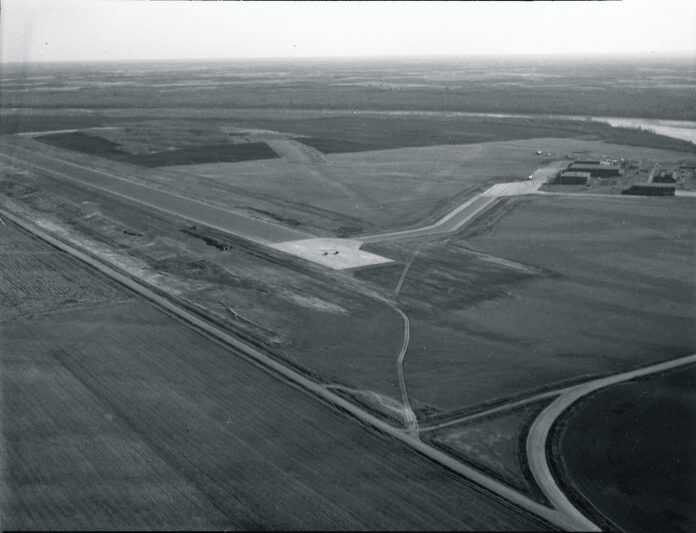by Joan Champ
If your family is like mine, dinner conversations often turn to “What would help to make Prince Albert a better city?” Of course, there are many answers to this question, including the suggestion that a bigger airport would help stimulate the city’s economic growth. This got me wondering about the history of Prince Albert’s airport—specifically, the development of its paved runway.
“Today we celebrate the beginning of a new era of development of our great Northland with the official opening of Prince Albert’s first paved airport runway,” said J. G. Diefenbaker, Member of Parliament for Prince Albert, on Saturday, September 23, 1956. After years of lobbying Ottawa by city officials, the new airstrip was celebrated by numerous dignitaries and a crowd of 5,000 people. The ceremony was followed by an air show sponsored by the Department of National Defence. “No events in the history of Prince Albert have been more important than this one, the opening of the hard-surfaced runway,” the Daily Herald quoted Diefenbaker. “It will play a most important role in the expansion of Prince Albert and Northern Saskatchewan.”
The history of the airstrip dates back to 1929 when the lands currently occupied by the airport were originally purchased. In the 1930s, companies like M & C Aviation used the grass runways of Prince Albert’s airport to run scheduled flights to northern destinations.
During the Second World War, the Department of National Defence invested in airport improvements at Prince Albert for the No. 6 Elementary Flying Training School (EFTS) under the British Commonwealth Air Training Plan. In 1941, No. 6 Air Observer School (AOS) was also established at the Prince Albert airport. Despite the contributions which Prince Albert made to Canada’s air effort during the Second World War, however, it was the only air training centre without a hard-surfaced runway by the end of the war. This was a source of frustration. Flying operations out of Prince Albert were hampered during wet weather, and maintenance costs were higher no matter what the conditions – all because of the turf airstrip.
After the war, Prince Albert continued to lobby Ottawa for a paved airport runway. Airports in other parts of Canada were given precedence over Prince Albert, however. In January 1953, the need for a hard-surfaced airstrip became particularly urgent when Canadian Pacific Airlines announced its plans to start flights into Prince Albert. The city could not add new facilities at the airport until hard-surfaced runways were installed. “We in Prince Albert are in danger of being bypassed and will be bypassed as time goes on,” Mayor J. M. Cuelenaere Q. C. stated in the Daily Herald. “Bigger aircraft need bigger and longer runways, no longer will an airfield consisting of grass and cow pasture fill the needs.”
Cuelenaere led a delegation to Ottawa to meet with the federal transport minister, Hon. Lionel Chevriet and Frank Helme, MP for Prince Albert. A few months later, in April 1953, the mayor received a telegram from Helme advising him that the federal government had set aside $500,000 for building of a paved airstrip in Prince Albert.
Surveying work began in the summer of 1953. To accommodate the 5,000-foot-long runway, the city had to acquire an additional 500 acres of land from two neighbouring farmers. A disagreement over the price led to expropriation proceedings. A settlement was reached in 1954 and the airstrip was opened to air traffic, including Canadian Pacific Airlines, in the fall of 1955.
What was termed as a cow pasture only four years earlier received a gala opening on September 24, 1956. The Daily Herald touted it as “one of Western Canada’s most modern airport runways.” In his speech at the event, Mayor D. G. Steuart emphasized that the completion of the paved airstrip was only “the first step in the development of our airport that eventually will be second to none in Western Canada.”
Since 1956, Prince Albert’s airport has experienced some growth. It was operated by Transport Canada until March 1996 when ownership and responsibility for operations were transferred to the City. Today, the airport has two runways – one paved and one turf – five taxiways, and four aprons. Since it opened in 1956, the paved runway has been resurfaced several times – most recently in 2012. The “Prince Albert Municipal Airport Master Plan” (March 2009) recommends that the paved runway be extended from its current 1,524 metres (5,000 feet) to 1,982 metres (6,500 feet) to enable larger aircraft to operate from the airport. A source at the airport states that there is no need to lengthen the runway at this time, however, because most of the flights in and out of Prince Albert mainly fly to northern destinations which have shorter airstrips.
Thanks to the Bill Smiley Archives for its assistance in the preparation of this column.
Contact: joanchamp@shaw.ca


